Big Reed Forest Reserve
categories: Cocktail Hour / Getting Outside
13 comments
Thanks to my friend Drew Barton, the forest ecologist immortalized in my my book Temple Stream, I got to go on a trip this past weekend to the Big Reed Forest Reserve, which protects the largest remnant of old-growth forest in New England (and likely well beyond). Our guides and hosts were Nancy Sferra and Dan Grenier, who are, respectively, the Director of Science and Stewardship and the Maine Preserves Manager for the Maine chapter of the Nature Conservancy. When I hear the words old growth my mind tends to conjure up enormous trees and pinecones the size of Volkwagens, but this isn’t the Pacific Northwest, it’s Maine, tough territory for forests and people alike. Instead what we found in the reserve were more than 4500 acres of undisturbed habitats, forest that has never been cut. Drew’s forthcoming book on the forests of Maine will explain that this happy circumstance came about first because the Big Reed area was too far from major rivers for easy log transport in the old days, and because more recently, early in the 20th century when the Pingree family bought the land, their forest manager saw the value of the uncut section and saw to it that it remained that way, stewardship that the Nature Conservancy (TNC) continues.
/
I’m just back from our trip. Big Reed is five hours from Farmington, the last two hours on dirt and gravel logging highways, most notably the Telos Road. And here’s the thing: our great north woods, a working forest, as it’s called, has been worked very hard and for a long time. As you drive, you have the feeling of being in great nature, it’s true–the sky is huge there, and the landscape vast–but also you can’t shake the fact that it’s an industrial setting. The forest heights along the road are not tall, and the forest itself is impassably thick with young trees in many places. Some cuts look beautifully done–and we do need our forest products, all of us–a lot of stock left standing, seed trees towering, not bad. Other cuts, and these are legal, too, look more like battle scenes, little left standing, the legal minimum, dusty roads cutting every which way, bulldozed yards, piles of barren rock.
/
For a while before you get to Telos, you pass through the Allagash Wilderness Waterway, which is a strip of preserved land on both sides of the famous canoe loop, about a half mile of nice regrowth forest altogether, sudden sense of height and green and species variety, but then it’s back to the more scruffy look of jobs and product. And before that, it’s gorgeous, too, great views of Ktaadn (as Thoreau spelled it), the West Branch of the Penobscot River coursing past, nearly swallowing a narrow bridge that sports warning signs for the tourist traffic: NO LOITERING ON BRIDGE. This territory is owned by the paper companies and their trucks have right of way. There’s been a lot of rain, what with Irene and last week’s storms, and the water is smashing under that bridge, spectacular, a large flock of common merganser juveniles plus mom paddling along and diving happily in the tumult.
/
Ravens in the sky, and flickers crossing the road, and dust from vehicles coming at you rarely. Finally, we’re at the North Maine Woods Checkpoint. Dan Grenier has left our names and the woman staffing the post seems happy to hear we’re with the Nature Conservancy. Another hour or so on the dusty gravel, one big turn, and we’re there. Drew and I wait at the wrong road a while, then (wisely) he decides we’d better try the next–they’re all named after the mileage from the checkpoint, and there are few road signs to offer any confidence. And sure enough, at the next road, Dan’s there waiting. He’s got his head shaved and wears a red forestry vest and sits up high in his TNC truck, big smile. Once, he was Drew’s student at UMF. Since then, he’s collected his Masters degree and found this dream job. Not to say it isn’t a difficult job.
/
Off the big road the forest looks more inviting, still cut over, but higher and deeper and cooler. Partridge juveniles rush across the two-track lesser road in front of us. Soon we’re at the end of the line, just a blunt stop in the woods. We re-pack, apportion supplies (not true–Dan carries most) and into the reserve we go on a mostly abandoned trail, plenty of deadfall and mud and many mushrooms and other fungi after all the rain, nice. It’s dusk. I’m carrying my dry-bag (which I’ve always called my wet-bag) and we’ve got my canoe paddles and a couple of life-preservers. It’s a mile and a half to Big Reed Pond, where an aluminum “courtesy” canoe waits. (Tradition was for sportsmen to leave beater canoes at ponds all over the north woods, but TNC discourages the practice, as they already own hundreds of derelict boats inherited with their land purchases over the years.)
/
And we paddle to a tiny cove where a cocked dock is hidden. Two tiny cabins are invisible on the bluff above. Nancy Sferra is waiting up there hungry on the porch with Dan’s seasonal assistant, Mike, a tall young man with a quick smile. Soon we’re cooking, or in my case drinking Jack Daniel’s, and soon again we’re eating a big meal and then trading scientist stories that devolve quite quickly (and with my avid help) into every sort of comic nonsense, lots of fun, barred owl hooting, loons calling, mice scrabbling.
/
Early I hear Nancy’s guitar and something of her pretty singing drifting out over the pond. Not long and we’re up and back in the canoes and paddling against the wind in the cold and so back to the path and back to the vehicles and to a logging road through well-cut Pingree family land to a spot from which we can access another corner of the Big Reed Reserve. We’re joined by a couple of grad students from the University of Maine and a lovely TNC donor named Carol, who’s a fan of the forest, all these knowledgeable people coming at the woods from different angles.
/
Immediately we’re lingering over an odd elderberry-looking thing trying to determine just what it is. Nancy asks for my binocs and turns them backwards, uses them for a microscope to inspect the remains of the diagnostic bloom. Who knew you could use binocs for a magnifying glass up close? My first lesson of the day. Or no–earlier, she’s shown me a plant called beech drops, which, like Indian paintbrush, is a parasitic flowering plant that lives off the roots of trees, as Drew will explain later.
/
And into the woods. It’s not overwhelming–that’s not it–it’s just overwhelmingly healthy and right. There are very big trees, yes, but what I notice most is all the dead material on the ground–huge boles, broken branches, uprooted everything, untouched. There are no rock walls, no grown-in logging roads, those features so familiar in the former farmland that makes our woods closer to home. There are no roads, no paths, no cut tree stumps, no sign of sawn anything. Instead there are huge stubs and many blowdowns and holes in the canopy where older trees have fallen, the new forest coming up below. The climax canopy is high above.
/
The discussion is about succession, about tree ages, about maximum heights, about DBHs, which turn out to be Diameters at Breast Height. There are a lot of acronyms, but no question is too dumb, and none goes unanswered when I ask it. A lot of the talk is about the past–what this place was, how it came to be, but much is also about the future. The scientists offer all sorts of observations. Moose are browsing the sugar maple saplings all to hell, Nancy points out. Are there going to be any left to grow tall? Or will other species dominate a hundred years hence? There aren’t any medium sugar maples around–they’re all huge or tiny. Scientific studies are referenced. Ideas are spun.
/
My favorite spot is a soggy bottom full of huge white cedars leaning this way and that, one so big we pause to measure it: huge.
/
Mushrooms, fungi. It’s a big year. I know just a little about the things, but Drew is generous enough to direct questions to me, and soon I’m the mushroom guy–thin expertise–dozens of species, ten or more of them coral mushrooms of dazzling variety and color schemes. [next post I’ll do a mushroom photo essay] I take on my role pretty shyly, knowing Nancy knows more than I do. But she’s nice too and lets me hold forth, and in the end I do seem to know something, quite a bit of it learned on the spot.
/
Between Nancy and Drew there’s no plant unknown, dazzling again. Drew picks up a liverwort log and carries it all the way to the group. We admire the old medicinal plant, and then make fun of him for bringing it to us. Half the day is laughter. There’s joy among giants.
/
We get to the opposite side of the pond from our cabins at exactly noon, and sit down to lunch, a happy group. I nap while Dan and Nancy explain the fate and possible restoration of the arctic char, a fish endemic to this pond and to only 11 others in Maine, another relic of a north woods past. I manage a nap while they talk, but somehow hear the whole thing, an heroic tale with ending as yet unknown.
/
Evening and we’re back at the cabins and the talk is all old growth, old growth and all the other places we want to see, promises to do more soon.

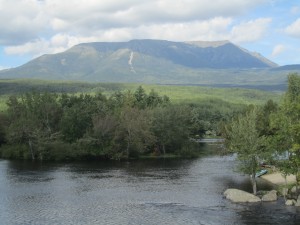
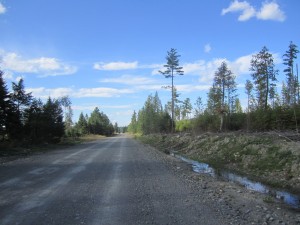
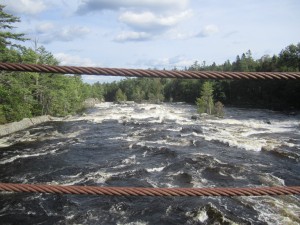
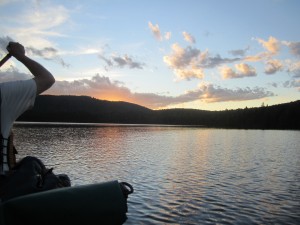
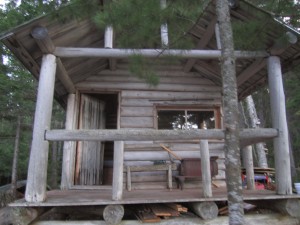

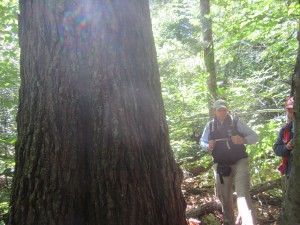
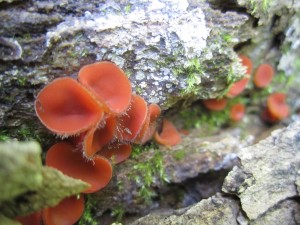


we plan to drive up from Greenville to see these old pines & perhaps fish Big Reed. is it necessary to be on a guided walk thru the preserve? who would we contact to set up a visit? please call/text or email me. thanks
Buz Brewster 949 378-2964
Contact the Nature Conservancy with questions about Big Reed. Great organization, great place!
Would like to be in the loop of all things about Reed Thanks so much for sharing your adventure
I have the great fortune for working with both Dan and Nancy. They are top notch, and we are lucky that they have chose to work at TNC. I have never been to Big Reed Pond, but I hold it in my imagination as a beacon of wildness. Thanks for the account, Bill.
It’s a beacon, all right. And with luck, less and less an island. With thanks to TNC.
That is my little brother, Dan. I am so very proud of him…who he is…what he does…and what he gives to others. Jac
Dan is a treasure. Maybe you and the family could buy him a wig?
Bill, thanks for the travelogue. I always wanted to go to Big Reed, and now I want to go even more. I want to go with Nancy Sferra. Maybe she’ll bring her National Steel. Thanks for a great job!
Phil Hoose
Phil, yes, you’ve got to get there. Dan and Nancy were great guides, and funny, too.
Hi, Bill: Dan sent me the link to your blog. It was a great trip. I thoroughly enjoyed myself and very happy to have met you. Dan , Nancy and Drew are the best. Have a great Fall. Carol.
Carol, it was great to meet you.
Thanks for a sharing your adventure at Big Reed Forest Reserve Bill. I enjoy hearing about all your wilderness wanderings in the Maine woods.
Thanks Laurie. I love wandering in the Maine woods–there seems to be an awful lot of it!